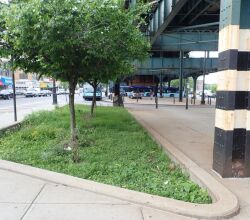Marcus Garvey Square
Marcus Garvey Square
What was here before?
In the eighteenth century, John Williams had a farm on the east bank of the Bronx River, and some credit him with building the first Bronx River crossing. Though the story is unproven, his farm was closest to the earliest bridge and by the 19th century, the bridge and surrounding community became known as Williamsbridge, the park’s namesake and previous name of E. Gun Hill Rd Bridge. The neighborhood has also been called Olinville.
In the mid-1800s, a dry goods store and post office were on the north side of the intersection. To the east, Briggs family heirs, one of the borough’s oldest families, owned several properties. On the southeast corner, Stephen Valentine, of another early Bronx family that often intermarried with the Briggs, operated a stage (or carriage) operation. By 1881, his business was replaced with the hotel Jerome Hall, which operated for a couple of decades.
How did this site become a park?
The City acquired this land in 1900 through condemnation for a street. Fifteen years later, the City named the public space Williamsbridge Square. The overhead train line opened in 1917, and the city transferred jurisdiction of the greenspace below to Parks in 1926. The park house that still stands was built in 1929 and served for several years as the Williamsbridge Baby Health Station of the New York City Department of Health. Today, this building is NYC Parks’ District 14 Headquarters.
In 2024 the park was renamed Marcus Garvey Square by local law to align with the street signage at the nearby intersection, which was installed several years prior. The renaming came after a campaign by the Jamaica Progressive League and residents who make up a largely Caribbean and African American neighborhood.
Who is this park named for?
Marcus Garvey Square is named for Marcus Mosiah Garvey (1887-1940), an early advocate of Black Nationalism and Black economic self-sufficiency.
Garvey was born in St. Ann’s Bay, Jamaica on August 17, 1887 and immigrated to Harlem in 1916, where in 1918 he established the headquarters of the Universal Negro Improvement Association (UNIA). At UNIA’s first convention, held at Madison Square Garden in 1920, Garvey declared his plans to build an independent nation in West Africa. The group promoted economic independence, published the Negro World newspaper, and established Black-owned businesses, including the Black Star Shipping Line.
Under increasing government scrutiny, Garvey’s plans foundered after his conviction for mail fraud in 1923. President Calvin Coolidge commuted his sentence after Garvey served two years in prison, and in 1927 he was deported to Jamaica. There he helped establish the first modern political organization, which focused on rights for the poor and working class. Garvey subsequently moved to London, where he died from complications of a stroke in 1940. Though several of his peers, including W.E.B. Du Bois and the NAACP, were critical of his separatist beliefs, his supporters focus on Garvey’s steadfast pride in African history and culture. Considered the founder of the “black is beautiful” idea, Garvey’s cultural movement continues to have a lasting impact on today’s society.
Check out your park's Vital Signs
Clean & Safe
Green & Resilient
Empowered & Engaged Users
Share your feedback or learn more about how this park is part of a
Vital Park System




